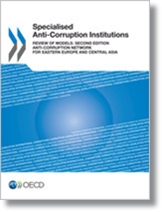Anti-Corruption Network › Specialised Anti-Corruption Institutions - Review of Models
Specialised Anti-Corruption Institutions - Review of Models
|
Date of publication
Access for government officials with OLIS accounts 2008 EDITION English (pdf) Russian (pdf) Ukrainian (pdf) |
2013 EditionExecutive summary International Standards and Models of Anti-corruption Institutions Sources of International Standards Elements of International Standards Models of Anti-corruption Institutions Selected Models of Specialised Anti-corruption Institutions
Countries reviewedAzerbaijan, Botswana, Brazil, Croatia, France, Hong Kong China, Indonesia, Latvia, Lithuania, FFYR Macedonia, Norway, Poland, Romania, Serbia, Singapore, Slovenia, Spain, United Kingdom, United States. This report provides a comparative overview of common standards and key features of specialised anti-corruption institutions and comprehensive descriptions of 19 anti-corruption institutions operating in different parts of the world, presented in a comparable framework. This new edition of an 2008 report reflects the evolving understanding of international standards and the practice and the most recent experiences of anti-corruption institutions. The report discusses three "models" of anti-corruption institutions: multi-functional anti-corruption agencies, institutions fighting corruption through law enforcement and prevention institutions. Encouraged by international conventions and success of some specialised anti-corruption institutions in earlier times, such as the Hong Kong’s anti-corruption commission, many countries around the world, including those in Eastern Europe, have created new specialised institutions to prevent and combat corruption over the past decade. Establishing such bodies was often seen as the only way to reduce widespread corruption, as existing institutions were considered too weak for the task, or were considered to be part of the corruption-problem. The report highlights that while many of these new anti-corruption agencies have shown good results, they cannot fight corruption alone. Other public institutions, including various specialised integrity and control bodies, and internal units in various public institutions should play a role in preventing and detecting corruption in different sectors of public administration.
|
Related Documents



Follow us
E-mail Alerts Blogs